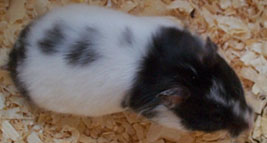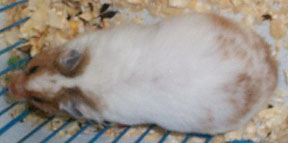
Contents
RRH Index
Extreme Dilute
Syrian Hamsters
Description
History
Genetics
Breeding
Experimental Proofs of
Gene Character and
Transmission
Albinism
ED Photo Gallery
Recessive Dappled
Syrian Hamsters
Description
History
Genetics
Breeding
Experimental Proofs of
Gene Character and
Transmission
Comparison to Other
Patterns
Testing for Allelism with
Dominant Spot
RD Photo Gallery
Working on Type
Syrian Hamster
Genetics
Contact
|
Recessive Dappled Compared to Other Recessive Dappled can be easily differentiated from other white patterns except for one — the combination pattern, Dominant Spot Banded, which has recently become standardized by the British Hamster Association. This one will be examined in detail with notes about the other patterns following.
The BHA Exhibition Standard (reproduced by permission) reads as follows: The dominant spotted banded shall have a coloured head and nape of neck with a central blaze of white running from the nose to between the ears. This area shall be evenly spotted with white. Spots of colour shall be distributed along the dorsal line from the neck to the rump, with the area from the rump to the tail evenly spotted with colour and white. The white band shall cover two thirds of the body length. The spots shall be sharply defined. The belly fur shall be white. The white areas shall be white to the roots. The coloured area shall conform to the recognised corresponding full coloured variety. Eye colour: As for the full coloured variety. Ruby/red eye or eyes permissable. Recessive Dappled shares with Dominant Spot the white belly, white facial blaze and spotted patterning.
Although there is no standard for Recessive Dappleds, features are consistent enough to contrast it with DS Banded.
Unlike Dominant Spot Banded, this pattern has no area that is consistently devoid of color. In other aspects, it contrasts with Recessive Dappled as above. White Banded hamsters ideally have a clear belt of white occupying the middle third of the body. Common faults range from a little spotting on the dorsal line to an almost absent band seen only as triangles of white extending up the sides from the white belly. The clear white "wide band" on a Recessive Dappled is always over the shoulders and in some individuals extends nearly to the tail. The margins of the band on a Banded should be straight, but even when they are jagged the white does not seriously extend fore or aft to simulate a spotted pattern. There is no facial blaze. Roaning consists of an admixture of white and colored hairs with the proportions varying considerably. The pattern occurs in Self hamsters except for Black, i.e., in cream-based colors. It is the effect of the dominant gene, Anophthalmic White, which in homozygotes is expressed as Eyeless White. Color is usually more concentrated on the head, but even when it fades to a predominantly white body, the white is never in organized spots.
Also caused by the Anophthalmic White gene, the White Bellied phenotype is seen in hamsters that are either Agouti or Black. In Agoutis, the belly is snow white as with the other patterns. In addition, there may be a grizzled effect owing to a slight scattering of white hairs, especially on the muzzle. On Black hamsters, the white is evident in an enlarged belly patch not covering the entire ventral surface and often mistaken for commonly seen white faults on Self hamsters. White markings are not seen on the upper parts of the animal. Piebald is the only other known Syrian hamster pattern caused by a recessive gene (symbolized s). No Piebald hamster has been seen in many years and the gene is presumed to be extinct. Old descriptions and photos in scientific papers indicate that the color was equally distributed over the back and belly, making it the only pattern gene to have ventral coloration. (Occasional color spot faults on the bellies of other patterned hamsters do not approach this equal distribution.) In contrast to Dominant Spots, the Piebald's spots were larger and less defined. This diminished definition may have been similar to the dappling on the rear of Recessive Dappled hamsters. |
|||||||||

No part of this website may be reproduced in any form or by any means
without the prior written consent of the owner.

